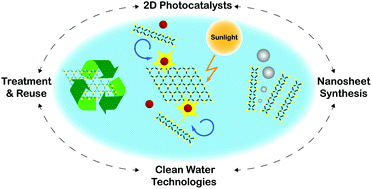Challenges surrounding nanosheets and their application to solar-driven photocatalytic water treatment
Abstract
Industrialisation has deepened the water crisis in arid climates, where wastewater runoff from heavy industry has polluted groundwater sources so heavily that traditional methods of water treatment have proven ineffective. Photocatalysis is an emerging technology which has the potential to treat water using only sunlight, but is unrealised using traditional, inefficient photocatalysts (e.g. TiO2). Recently, a slew of visible light active 2D nanomaterials such as MoS2 and g-C3N4, have shown great promise, with others playing an essential supporting role in larger composites (e.g. graphene). Scalable synthesis of these nanosheets has remained elusive, as they require careful synthesis tailored towards their role within a photocatalytic composite. Along with recovering the nanosheets post-treatment, these remain the greatest challenges barring the adoption of these materials more generally. Through this review, we find that research into nanosheet-based photocatalysis should focus on developing materials from a systems level perspective, with careful consideration taken to how the material presented is to be applied in clean water technologies and synthesised from its base components.

- This article is part of the themed collections: Recent Review Articles and Celebrating Materials Science in the UK


 Please wait while we load your content...
Please wait while we load your content...